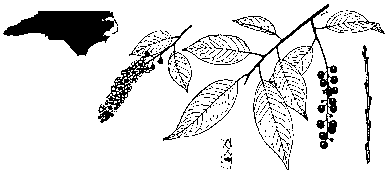|
Black
Cherry
(Prunus
serotina Ehrh..)
|
|
| |
 |
|
| |
Black cherry, often called wild
cherry, grows in all parts of the state but it grows best in the
high mountains. It does not grow well on sites that are swampy
or dry. Black cherry leaves are 2 to 6 inches long and 3/4 to
1 1/2 inch wide. They are narrowly oval or oblong and are pointed.
Leaf edges are finely toothed with incurvate teeth. The base of
the midrib is covered with rusty colored pubescence.
The white flowers bloom when the leaves are about half-grown,
occurring on stems 4 to 6 inches long. As the fruit develops,
the flower stalks, or racemes, gradually droop as the cherries
reach full size (1/3 to 1/2 inch diameter). The cherries are dark
red when they are fully developed and turn black with dark purple
flesh as they ripen. They are food for wild animals and birds.
Black cherry is the largest of the native cherries of the United
States -- and the only one of commercial value. The tree reaches
60 to 100 feet or more in height and I to 5 feet in diameter.
Forest grown trees have long, limb-free trunks with little taper;
open grown trees have short trunks with many branches and irregular
spreading crowns.
The bark on the branches and trunks of young trees is thin, satiny,
reddish brown, with horizontal markings made up of patches or
rows of lenticels. Bark on older black cherry trees consists of
small scaly plates with slightly upraised edges. (Lenticels are
small openings in the bark of twigs; they usually are surrounded
by rough, corky tissue.) Leaves and twigs have a very strong odor
of bitter almonds. This characteristic helps to identify the cherry
when it is growing with sweet birch or hop hornbearn.
The wood is reddish-brown with yellowish sapwood. It is moderately
heavy, hard, strong, and fine-grained. Black cherry is valuable
for its lustre and color and is used for furniture, interior finish,
tools and tool handles. With the exception of black walnut, cherry
lumber is more valuable than any other tree of the eastern United
States. |
|
|

